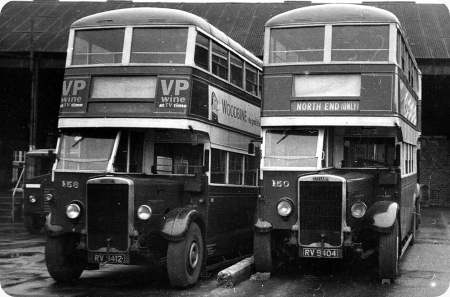Portsmouth Corporation – Leyland TD4 – RV 9404 – 150
Portsmouth Corporation
1937
Leyland Titan TD4
Cravens H26/24R
Having dabbled with Leyland TD1 & 2’s, Crossley Condors, an AEC Regent and some TSM’s, with bodies spread amongst Short, Park Royal, Leyland and English Electric, CPPTD settled on a large order for 30 Leyland TD4’s with Cravens’ bodies, to the same pattern as its trolleybuses, both types being delivered in two tranches during 1936/37.
There were subtle differences between bus/trolleybus bodies, notably the upstairs bus front windows lacking a curve at the bottom corners. Also, the last five (156-60), as can be seen from the photo, had different headlamps, plus fluting on the front nearside wing.
The buses had long lives, with engineering staff rebuilding bodies of some of them around 1950 and the last going in 1960! Both in the photo, with rebuilt bodies, lasted from 1937 to 1958. One was destroyed in 1941 by enemy action.
It’s the side-issues which often intrigue in bus photos and this one’s no exception. To our left of 158, peeps out part of a lorry. This was 105/RV2000, a 1932 Crossley Condor/EE double-decker, which was a CPPTD conversion to a waste disposal lorry after revenue-service withdrawal in 1948.
Photograph and Copy contributed by Chris Hebbron
———
03/06/12 – 19:41
Thanks Chris for another fine picture of Portsmouth Corporation pre-war Leyland TD4s. These were the days when one could be proud of your locally owned bus services which met the needs of community. The Transport Acts from 1968 onwards towards privatisation in the eighties have all produced changes, many for the worse. Happily this website draws the line at 1970 but my favourites are buses and trolleybuses of the 1930 to 1950 period.
Richard Fieldhouse
———
04/06/12 – 11:35
Oh how I agree with Richard about this superb posting from Chris!
Each municipality was so different, and they each exuded their own character and "flavour", as there was no central control from outside the town or city.
There was, in the municipal fleet, the opportunity to express some civic pride, with individual liveries, crests, coats of arms, and well (generally) maintained fleets.
Sadly, those days of pride , with some social discipline connected to it, have largely disappeared.
These 2 Titans could not be anywhere but Portsmouth, a fleet which took pride in its appearance. There were many others, but it is this individuality which is at the root of my enthusiasm, and hence, like Richard, it declines rapidly after 1950.
Not to say that other transport groupings were of no interest, as company and independent fleets also had character, but this was displayed in a different way.
Nostalgic and foolish old person that I am!
John Whitaker
———
04/06/12 – 17:11
You’re not wrong, Richard, about Transport acts. Before deregulation buses were classified as Public Service Vehicles, where as now they are Passenger Carrying Vehicles, no mention of ‘Passengers or Service’ I think that just about sums it up
Ronnie Hoye
———
05/06/12 – 08:28
The point John Whitaker makes about the old municipalities and their civic pride is all too true as control originated with in a short distance of where operations took place, by the same token criticisms and complaints could also be dealt with equally rapidly.
I worked both as conductor and driver for Eastbourne Corporation from 1961 to 1969 which at that time had a fleet of about 50 buses, a small fleet but beautifully maintained and turned out at all times. The coach painting was carried out solely by brush when repaints were due, no spray equipment was owned at that time, all this was done by two very skilled men namely Bill Hollobone and Reg Metcalfe. Reg even painted every advert panel by hand truly a work of art and a source of great pride, and a joy to watch in action.
Things definitely ain’t what they used to be, nostalgia rules OK.
Diesel Dave
———
06/06/12 – 09:50
You’re both so right, folks, about the special aspects of municipal fleets. CPPTD also had some hand-painted adverts, usually for local concerns. And the management had a fair degree of autonomy as well: it tends to be forgotten that these were publicly-owned ‘proper’ businesses and other employees of the councils, including councillors, tended to leave them alone, as long as they were, at least, self-supporting.
When I worked for GPO Telephones, we were always conscious that we were the only government-run business, but here, we were always constrained by government tight-fistedness, never giving us enough money to get rid of waiting lists/have the latest technology for a world-beating telephone service (until privatisation, that is). But that’s another story!
Chris Hebbron
Quick links to the - Comments Page - Contact Page - Home Page
Comments - Please note: The comments facility is not currently available. Please see the home page for updates.
Please Note if you want to send a photograph with your comment please use the Contact Page by clicking here or send as an attachment via email.


